What Star Wars Movies Does Disney Own
- "A long time ago in a galaxy far, far away..."
- ―Opening phrase
Star Wars is an American epic space opera franchise centered on a film series created by George Lucas. The popular film series has spawned an extensive media franchise which is organised as canon. The Expanded Universe includes books, television series, computer and video games, and comic books. These supplements to the three film trilogies have resulted in significant development of the series' fictional universe.
These media have kept the franchise active in the interim between the film trilogies. The franchise depicts a galaxy described as far, far away in the distant past, and it commonly portrays Jedi as a representation of good as they fight for the Republic, in conflict with the Sith, their evil counterparts who fight for the Empire. Their weapon of choice, the lightsaber, is commonly recognized in popular culture. The fictional universe also contains many themes, especially influences of philosophy and religion.
The first film, A New Hope, was originally released on May 25, 1977, under the title Star Wars, by 20th Century Studios, and became a worldwide pop culture phenomenon, followed by two sequels, released at three-year intervals. Sixteen years after the release of the trilogy's final film, the first in a new prequel trilogy of films was released. The three prequel films were also released at three-year intervals, with the final film of the trilogy released on May 19, 2005.
Reactions to the original trilogy were mostly positive, with the last film being considered the weakest, while, inversely, the prequel trilogy received a more mixed reaction, with most of the praise being for the final movie, according to most review aggregator websites. All six of the main films in the series were also nominated for or won Academy Awards. All of the main films have been box office successes, with the overall box office revenue generated by the Star Wars films (including the theatrical Star Wars: The Clone Wars) totaling $5.4 billion, making it the fourth-highest-grossing film series. The success has also led to multiple re-releases in theaters for the series.
In October 2012, The Walt Disney Company bought Lucasfilm for $4.05 billion and announced that it would produce three new films, with the first film, Star Wars: The Force Awakens, released in 2015. Despite the Walt Disney Company's 2012 purchase of Lucasfilm and the release rights to all future Star Wars films, Fox was to retain original distribution rights to Star Wars: A New Hope, which they co-produced and co-financed, in perpetuity in all media worldwide. Fox was also to retain theatrical, nontheatrical, and home video rights worldwide for the franchise's five subsequent films, which Lucasfilm produced and financed independently, through May 2020, at which time ownership was to transfer to Disney. This complex relationship between Fox and Disney, particularly in regards to Fox's perpetual rights to Episode IV, was to create an obstacle for any future boxed set comprising all nine films.[1] On December 14, 2017, the Walt Disney Company announced that it is acquiring most of Fox's parent company, 21st Century Fox, including the film studio and all distribution rights to A New Hope.[2] Currently, it is one of Disney's four main branches, the other three being the Marvel Cinematic Universe, Pixar and the Disney Animated Canon.
In 2015, Moff Mors was introduced in the Star Wars: Lords of the Sith novel and Aphra was introduced in Star Wars: Darth Vader from Marvel Comics. They are the first LGBT characters in Star Wars, and Disney currently has LGBT characters in all of their major branches (the Disney Animated Canon has Bucky and Pronk Oryx-Antlerson, Pixar has Specter and the Marvel Cinematic Universe has Valkyrie and Loki).
Contents
- 1 Theatrical films
- 1.1 Plot overview
- 1.2 Production history
- 1.2.1 Original trilogy
- 1.2.2 Prequel Trilogy
- 1.2.3 Sequel trilogy
- 1.2.4 Anthology series
- 1.2.5 3D Re-releases
- 1.2.6 New Trilogy
- 1.2.7 New Series
- 2 Cast and crew
- 2.1 Cast
- 2.2 Crew and other
- 3 Box office performance
- 4 Critical reaction
- 4.1 Academy Awards
- 5 Expanded Universe
- 5.1 Other films
- 5.2 Animated series
- 6 Attractions
- 7 Trivia
- 8 Gallery
- 9 References
- 10 External links
Theatrical films
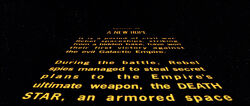
Each of the Star Wars films (aside from Rogue One) starts with an opening crawl.
The film series began with Star Wars, released on May 25, 1977. This was followed by two sequels: The Empire Strikes Back, released on May 21, 1980, and Return of the Jedi, released on May 25, 1983. The opening crawl of the sequels disclosed that they were numbered as "Episode V" and "Episode VI" respectively, though the films were generally advertised solely under their subtitles. Though the first film in the series was simply titled Star Wars, with its 1981 re-release it had the subtitle Episode IV: A New Hope added to remain consistent with its sequel and to establish it as the middle chapter of a continuing saga.
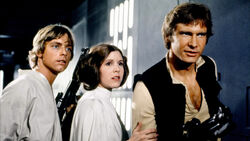
"The farm boy, the princess, and the smuggler": 1977 promo shot of the three main heroes.
In 1997, to correspond with the twentieth anniversary of A New Hope, Lucas released a "Special Edition" of the Star Wars trilogy to theaters.
The re-release featured alterations to the three films, primarily motivated by the improvement of CGI and other special effects technologies, which allowed visuals that were not possible to achieve at the time of the original filmmaking. Lucas continued to make changes to the films for subsequent releases, such as the VHS and Laserdisc Special Edition release on August 27, 1997, the first-ever DVD release of the original trilogy on September 21, 2004, and the first-ever Blu-ray release of all six films on September 16, 2011.
More than two decades after the release of the original film, the series went on with the long-awaited prequel trilogy, consisting of Episode I: The Phantom Menace, released on May 19, 1999; Episode II: Attack of the Clones, released on May 16, 2002; and Episode III: Revenge of the Sith, released on May 19, 2005.
On August 15, 2008, Star Wars: The Clone Wars was released theatrically as a lead-in to the weekly animated TV series of the same name.
In 2013, the original Star Wars film was the first Hollywood movie to be dubbed into Navajo.
On that day, a 27-DVD box set containing all nine films was released, exclusive to Best Buy. The box contains three discs — Blu-ray, 4K, and bonus features — for each film.
Plot overview

Qui-Gon Jinn and Obi-Wan Kenobi duel against Darth Maul in Episode I.
The prequel trilogy with the Trade Federation blockading the planet Naboo, in response to the Galactic Republic's taxation of trade routes. The Sith Lord Darth Sidious had secretly planned the blockade to give his alter ego, Senator Palpatine, a pretense to overthrow and replace the Supreme Chancellor of the Republic. At the Chancellor's request, Jedi Knights Qui-Gon Jinn and his apprentice Obi-Wan Kenobi are sent to Naboo to negotiate with the Federation but are forced to instead help the planet's monarch, Padmé Amidala, escape from the blockade and plead her case before the Galactic Senate on Coruscant.
When their spaceship is damaged during the escape, they land on the desert planet Tatooine for repairs, where Qui-Gon discovers a young slave named Anakin Skywalker. Qui-Gon comes to believe that Anakin is the "Chosen One" foretold by Jedi prophecy to bring balance to the Force, and he helps liberate the boy.
The Jedi Council, led by Yoda, reluctantly allows Obi-Wan to train Anakin after Qui-Gon is killed by Palpatine's first apprentice, Darth Maul, during the Battle of Naboo. When evil comes and tries to take over they fight back with strength and gratitude.
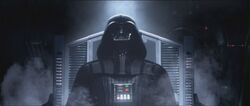
Birth of Darth Vader, Episode III.
The remainder of the prequel trilogy chronicles Anakin's gradual fall to the dark side of the Force as he fights in the Clone Wars, which Palpatine secretly engineers to destroy the Republic and lure Anakin into his service. Anakin and Padmé fall in love and secretly wed, and eventually, Padmé becomes pregnant. Anakin has a prophetic vision of Padmé dying in childbirth, and Palpatine convinces him that the dark side holds the power to save her life; desperate, Anakin submits to the dark side and takes the Sith name, Darth Vader.
While Palpatine re-organizes the Republic into the tyrannical Galactic Empire—appointing himself Emperor for life—Vader participates in the extermination of the Jedi Order, culminating in a lightsaber battle between himself and Obi-Wan on the volcanic planet Mustafar. Obi-Wan defeats his former apprentice and friend, severing his limbs and leaving him for dead. Palpatine arrives shortly afterward and saves Vader, placing him into a mechanical suit of armor that keeps him alive. At the same time, Padmé dies while giving birth to twins Luke and Leia Organa. The twins are hidden from Vader and are not told who their real parents are.
The original trilogy begins 19 years later as the Death Star space station nears completion, which will allow the Empire to crush the Rebel Alliance, an organized resistance formed to combat Palpatine's tyranny. Vader captures Princess Leia, who has stolen the plans to the Death Star and hidden them in the astromech droid R2-D2. R2, along with his protocol droid counterpart C-3PO, escapes to Tatooine. There, the droids are purchased by Luke Skywalker and his step-uncle and aunt.
While Luke is cleaning R2, he accidentally triggers a message put into the droid by Leia, who asks for assistance from Obi-Wan.
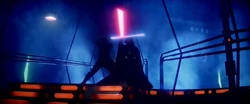
Luke and Darth Vader clash on Bespin.
Luke later assists the droids in finding the Jedi Knight, who is now passing as an old hermit under the alias Ben Kenobi. When Luke asks about his father, Obi-Wan tells him that Anakin was a great Jedi who was betrayed and murdered by Vader. Obi-Wan and Luke hire the smuggler/pilot Han Solo and his Wookiee co-pilot Chewbacca of the Millennium Falcon to take them to Alderaan, Leia's homeworld, which they eventually find has been destroyed by the Death Star.
Once on board the space station, Obi-Wan allows himself to be killed during a lightsaber rematch with Vader; his sacrifice allows the group to escape with the plans that help the rebels destroy the Death Star. Luke himself fires the shot that destroys the deadly space station.
Three years later, Luke travels to find Yoda, now living in exile on the swamp-infested world Dagobah, to begin his Jedi training. However, Luke is interrupted when Vader lures him into a trap by capturing Han and the others. During a fierce lightsaber duel, Vader reveals that he is Luke's father and attempts to turn him to the dark side. Luke escapes, and, after rescuing Han from the gangster Jabba the Hutt a year later, returns to Yoda to complete his training.
However, now over 900 years old, Yoda is on his deathbed. Before he passes away, Yoda confirms that Darth Vader is Luke's father; moments later, Obi-Wan's spirit tells Luke that he must face his father before he can become a Jedi and that Leia is his twin sister. As the Rebels attack the second Death Star, Luke confronts Vader as Palpatine watches; both Sith Lords intend to turn Luke to the dark side and take him as their apprentice.
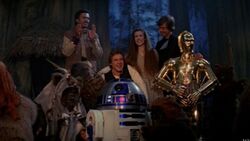
Final shot of the original trilogy.
During the subsequent lightsaber duel, Luke succumbs to his anger and brutally overpowers Vader, but controls himself at the last minute; realizing that he is about to suffer his father's fate, he spares Vader's life and proudly declares his allegiance to the Jedi. An enraged Palpatine then attempts to kill Luke with Force lightning, a sight that moves Vader to turn and kill his master, suffering mortal wounds in the process. Redeemed, Anakin Skywalker dies in his son's arms. Luke becomes a full-fledged Jedi, and the Rebels destroy the second Death Star.
Production history
Original trilogy
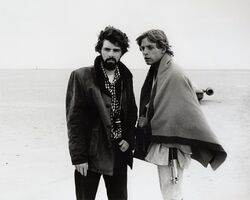
George Lucas (left) and Mark Hamill during production on A New Hope.
In 1971, Universal Studios agreed to make American Graffiti and Star Wars in a two-picture contract, although Star Wars was later rejected in its early concept stages. American Graffiti was completed in 1973 and, a few months later, Lucas wrote a short summary called "The Journal of the Whills", which told the tale of the training of apprentice CJ Thorpe as a "Jedi-Bendu" space commando by the legendary Mace Windy. Frustrated that his story was too difficult to understand, Lucas then began writing a 13-page treatment called The Star Wars on April 17, 1973, which had thematic parallels with Akira Kurosawa's The Hidden Fortress. By 1974, he had expanded the treatment into a rough draft screenplay, adding elements such as the Sith, the Death Star, and a protagonist named Annikin Starkiller.
For the second draft, Lucas made heavy simplifications and introduced the young hero on a farm as Luke Starkiller. Annikin became Luke's father, a wise Jedi knight. "The Force" was also introduced as a mystical energy field. The next draft removed the father's character and replaced him with a substitute named Ben Kenobi, and in 1976 a fourth draft had been prepared for principal photography. The film was titled Adventures of Luke Starkiller, as taken from the Journal of the Whills, Saga I: The Star Wars. During production, Lucas changed Luke's name to Skywalker and altered the title to simply The Star Wars and finally Star Wars.
At that point, Lucas was not expecting the film to become part of a series. The fourth draft of the script underwent subtle changes that made it more satisfying as a self-contained film, ending with the destruction of the Empire itself by way of destroying the Death Star. However, Lucas had previously conceived of the film as the first in a series of adventures. Later, he realized the film would not be the first in the sequence, but a film in the second trilogy in the saga. This is stated explicitly in George Lucas' preface to the 1994 reissue of Splinter of the Mind's Eye:
- "It wasn't long after I began writing Star Wars that I realized the story was more than a single film could hold. As the saga of the Skywalkers and Jedi Knights unfolded, I began to see it as a tale that could take at least nine films to tell—three trilogies—and I realized, in making my way through the back story and after story, that I was really setting out to write the middle story."
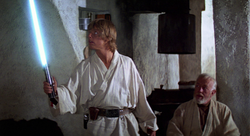
Luke activates his first lightsaber.
The second draft contained a teaser for a never-made sequel about "The Princess of Ondos", and by the time of the third draft some months later Lucas had negotiated a contract that gave him rights to make two sequels. Not long after, Lucas met with author Alan Dean Foster and hired him to write these two sequels as novels. The intention was that if Star Wars were successful, Lucas could adapt the novels into screenplays. He had also by that point developed an elaborate backstory to aid his writing process.
When Star Wars proved successful, Lucas decided to use the film as the basis for an elaborate serial, although at one point he considered walking away from the series altogether. However, Lucas wanted to create an independent filmmaking center—what would become Skywalker Ranch—and saw an opportunity to use the series as a financing agent. Alan Dean Foster had already begun writing the first sequel novel, but Lucas decided to abandon his plan to adapt Foster's work; the book was released as Splinter of the Mind's Eye the following year.
At first, Lucas imagined a series of films with no set number of entries, like the James Bond series. In an interview with Rolling Stone in August 1977, he said that he wanted his friends to each to take a turn at directing the films and giving unique interpretations of the series. He also said that the backstory in which Darth Vader turns to the dark side, kills Luke's father and fights Ben Kenobi on a volcano as the Galactic Republic falls would make an excellent sequel.
Later that year, Lucas hired science fiction author Leigh Brackett to write Star Wars II with him. They held story conferences and, by late November 1977, Lucas had produced a handwritten treatment called The Empire Strikes Back. The treatment is very similar to the final film, except that Darth Vader does not reveal he is Luke's father. In the first draft that Brackett would write from this, Luke's father appears as a ghost to instruct Luke.
Brackett finished her first draft in early 1978; Lucas has said he was disappointed with it, but before he could discuss it with her, she died of cancer. With no writer available, Lucas had to write his next draft himself. It was this draft in which Lucas first made use of the "Episode" numbering for the films; Empire Strikes Back was listed as Episode II. As Michael Kaminski argues in The Secret History of Star Wars, the disappointment with the first draft probably made Lucas consider different directions in which to take the story.
He made use of a new plot twist: Darth Vader claims to be Luke's father. According to Lucas, he found this draft enjoyable to write, as opposed to the yearlong struggles writing the first film, and quickly wrote two more drafts, both in April 1978. He also took the script to a darker extreme by having Han Solo imprisoned in carbonite and left in limbo.
This new story point of Darth Vader being Luke's father had drastic effects on the series. Michael Kaminski argues in his book that it is unlikely that the plot point had ever seriously been considered or even conceived of before 1978, and that the first film was operating under an alternate storyline where Vader was separate from Luke's father; there is not a single reference to this plot point before 1978.
After writing the second and third drafts of The Empire Strikes Back in which the point was introduced, Lucas reviewed the new backstory he had created: Anakin Skywalker was Ben Kenobi's brilliant student and had a child named Luke, but was swayed to the dark side by Emperor Palpatine (who became a Sith and not simply a politician). Anakin battled Ben Kenobi on the site of a volcano and was wounded, but then resurrected as Darth Vader. Meanwhile, Kenobi hid Luke on Tatooine while the Republic became the Empire and Vader systematically hunted down and killed the Jedi.
With this new backstory in place, Lucas decided that the series would be a trilogy, changing Empire Strikes Back from Episode II to Episode V in the next draft. Lawrence Kasdan, who had just completed writing Raiders of the Lost Ark, was then hired to write the next drafts and was given additional input from director Irvin Kershner. Kasdan, Kershner, and producer Gary Kurtz saw the film as a more serious and adult film, which was helped by the new, darker storyline, and developed the series from the light adventure roots of the first film.
By the time he began writing Episode VI in 1981 (then titled Revenge of the Jedi), much had changed. Making Empire Strikes Back was stressful and costly, and Lucas' personal life was disintegrating. Burned out and not wanting to make any more Star Wars films, he vowed that he was done with the series in a May 1983 interview with Time magazine. Lucas' 1981 rough drafts had Darth Vader competing with the Emperor for possession of Luke—and in the second script, the "revised rough draft", Vader became a sympathetic character. Lawrence Kasdan was hired to take over once again and, in these final drafts, Vader was explicitly redeemed and finally unmasked. This change in character would provide a springboard to the "Tragedy of Darth Vader" storyline that underlies the prequels.
Prequel Trilogy
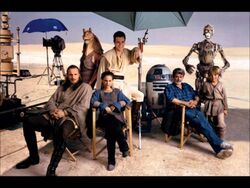
SWE1 production cast.
After losing much of his fortune in a divorce settlement in 1987, Lucas had no desire to return to Star Wars and had unofficially canceled his sequel trilogy by the time of Return of the Jedi. Nevertheless, the prequels, which were quite developed at this point, continued to fascinate him. After Star Wars became popular once again, in the wake of Dark Horse's comic book line and Timothy Zahn's trilogy of novels, Lucas saw that there was still a large audience. His children were older, and with the explosion of CGI technology, he was now considering returning to directing.
By 1993, it was announced, in Variety among other sources, that he would be making the prequels. He began outlining the story, now indicating the series would be a tragic one examining Anakin Skywalker's fall to the dark side. Lucas also began to change how the prequels would exist relative to the originals; at first, they were supposed to be a "filling-in" of history tangential to the originals, but now he saw that they could form the beginning of one long story that started with Anakin's childhood and ended with his death. This was the final step towards turning the film series into a "Saga".
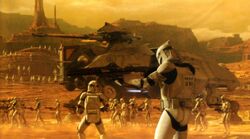
The Clone Wars.
In November 1994, Lucas began writing the first screenplay titled Episode I: The Beginning. Following the release of that film, Lucas announced that he would also be directing the next two, and began working on Episode II at that time. The first draft of Episode II was completed just weeks before principal photography, and Lucas hired Jonathan Hales, a writer from The Young Indiana Jones Chronicles, to polish it. Unsure of a title, Lucas had jokingly called the film "Jar Jar's Great Adventure".
In writing The Empire Strikes Back, Lucas initially decided that Lando Calrissian was a clone and came from a planet of clones which caused the "Clone Wars" mentioned by Princess Leia in A New Hope; he later came up with an alternate concept of an army of clone shock troopers from a remote planet which attacked the Republic and was repelled by the Jedi. The basic elements of that backstory became the plot basis for Episode II, with the new wrinkle added that Palpatine secretly orchestrated the crisis.
Lucas began working on Episode III before Attack of the Clones was released, offering concept artists that the film would open with a montage of seven Clone War battles. As he reviewed the storyline that summer, however, he says he radically re-organized the plot. Michael Kaminski, in The Secret History of Star Wars, offers evidence that issues in Anakin's fall to the dark side prompted Lucas to make massive story changes, first revising the opening sequence to have Palpatine kidnapped and his apprentice, Count Dooku, murdered by Anakin as the first act in the latter's turn towards the dark side.
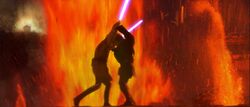
"Battle of the Heroes".
After principal photography was completed in September 2003, Lucas made even more massive changes in Anakin's character, re-writing his entire turn to the dark side; he would now turn primarily in a quest to save Padmé's life, rather than the previous version in which that reason was one of several, including that he genuinely believed that the Jedi were evil and plotting to take over the Republic. This fundamental re-write was accomplished both through editing the principal footage, and new and revised scenes filmed during a second block of photography in 2004.
Lucas often exaggerated the amount of material he wrote for the series; much of it stemmed from the post‐1978 period when the series grew into a phenomenon. Michael Kaminski explained that these exaggerations were both publicity and security measures. Kaminski rationalized that since the series' story radically changed throughout the years, it was always Lucas' intention to change the original story retroactively because audiences would only view the material from his perspective. When congratulating the producers of the TV series Lost in 2010, Lucas himself jokingly admitted, "when Star Wars first came out, I didn't know where it was going either. The trick is to pretend you've planned the whole thing out in advance. Throw in some father issues and references to other stories – let's call them homages – and you've got a series".
Sequel trilogy
The sequel trilogy was a trilogy of films (Episodes VII, VIII, and IX) reportedly planned by Lucasfilm as a sequel to the original Star Wars trilogy (Episodes IV, V, and VI) released between 1977 and 1983. While the similarly discussed Star Wars prequel trilogy (Episodes I, II, and III) was ultimately released between 1999 and 2005, Lucasfilm and George Lucas have for many years denied plans for a sequel trilogy, insisting that Star Wars is meant to be a six-part series. In May 2008, speaking about the upcoming Star Wars: The Clone Wars, Lucas maintained his status on the sequel trilogy:
- "I get asked all the time, 'What happens after Return of the Jedi?,' and there really is no answer for that. The movies were the story of Anakin Skywalker and Luke Skywalker, and when Luke saves the galaxy and redeems his father, that's where that story ends."
- ―George Lucas
In January 2012, Lucas announced that he would step away from blockbuster films and instead produce smaller art-house films. In an interview regarding whether or not the scrutiny he received from the prequel trilogy and the alterations made on the original trilogy were a factor in his retirement, Lucas stated:
- "Why would I make any more,... when everybody yells at you all the time and says what a terrible person you are?"
In October 2012, The Walt Disney Company agreed to buy Lucasfilm and announced that a new Star Wars Episode VII film will be released in 2015. The co-chairman of Lucasfilm, Kathleen Kennedy became president of the company, reporting to Walt Disney Studios chairman Alan Horn. Also, Kennedy serves as executive producer on new Star Wars feature films, with franchise creator and Lucasfilm founder Lucas serving as creative consultant. The screenplay for Episode VII will be written by Michael Arndt. On January 25, 2013, The Walt Disney Studios and Lucasfilm officially announced J. J. Abrams as director and producer of Star Wars Episode VII (now titled Star Wars: The Force Awakens), along with Bryan Burk through Abrams' production company Bad Robot Productions.
On November 20, 2012, The Hollywood Reporter reported that Lawrence Kasdan, writer of Empire and Jedi, and Simon Kinberg would write and produce Episodes VIII and IX. Kasdan and Kinberg were later confirmed as creative consultants on those films, in addition to writing stand-alone films. Also, John Williams, who wrote the music for the previous six episodes, has been hired to compose the music for Episodes VII, VIII, and IX.
Anthology series
On February 5, 2013, Disney CEO Bob Iger confirmed the development of two stand-alone films, each individually written by Lawrence Kasdan and Simon Kinberg. On February 6, Entertainment Weekly reported that Disney is working on two films featuring Han Solo and Boba Fett. In April 2015, Lucasfilm and Kennedy announced that the standalone films would be referred to as the Star Wars Anthology films.
The first of the Anthology series films, Rogue One, directed by Gareth Edwards, was released on December 16, 2016. Rogue One, set immediately before the events of A New Hope focuses on a group of rebels on a mission to steal the plans to the Death Star.
The next film in the anthology series — Solo, a film focusing on a young Han Solo, as directed by Ron Howard — was released on May 25, 2018.
3D Re-releases
At a ShoWest convention in 2005, Lucas demonstrated new technology and stated that he planned to release the six films in a new 3D film format, beginning with A New Hope in 2007. However, by January 2007, Lucasfilm stated on StarWars.com that "there are no definitive plans or dates for releasing the Star Wars saga in 3-D." At Celebration Europe in July 2007, Rick McCallum confirmed that Lucasfilm is "planning to take all six films and turn them into 3-D," but they are "waiting for the companies out there that are developing this technology to bring it down to a cost level that makes it worthwhile for everybody."
In July 2008, Jeffrey Katzenberg, the CEO of DreamWorks Animation, revealed that Lucas planned to redo all six of the movies in 3D. In late September 2010, it was announced that The Phantom Menace would be theatrically re-released in 3-D on February 10, 2012. However, the 3D re-releases of episodes II and III were postponed to enable Lucasfilm to concentrate on The Force Awakens.
New Trilogy
On November 9, 2017, Lucasfilm announced that a new Star Wars trilogy was to be helmed by The Last Jedi director Rian Johnson. The trilogy, while setting in the same galaxy, follows another story outside of the Skywalker Saga.
New Series
On February 6, 2018, another series of films separate from both the Skywalker Saga and Johnson's trilogy were to be written and produced by Game of Thrones creators David Benioff and D.B. Weiss. Since then, however, they left production and the future of the series is up in the air.
Cast and crew
Cast
| Character | A New Hope | The Empire Strikes Back | Return of the Jedi | The Phantom Menace | Attack of the Clones | Revenge of the Sith | The Force Awakens | ||||
|---|---|---|---|---|---|---|---|---|---|---|---|
| Anakin Skywalker/Darth Vader | David Prowse | David Prowse | Vader: David Prowse | Jake Lloyd | Hayden Christensen | Hayden Christensen | Mentioned only | ||||
| voice of Darth Vader | James Earl Jones | James Earl Jones | |||||||||
| Obi-Wan Kenobi | Alec Guinness | Ewan McGregor | Alec Guinness (archival audio) Ewan McGregor (voice only) | ||||||||
| R2-D2 | Kenny Baker | ||||||||||
| C-3PO | Anthony Daniels | Anthony Daniels (voice only) | Anthony Daniels | ||||||||
| Yoda | Frank Oz (voice and puppeteering) | Frank Oz (voice and puppeteering/voice only; post-2011 versions) | Frank Oz (voice only) | ||||||||
| Palpatine / Darth Sidious | Mentioned only | Elaine Baker Clive Revill (voice only) Ian McDiarmid (post-2004 versions) | Ian McDiarmid | ||||||||
| Leia Organa | Carrie Fisher | Aidan Barton | Carrie Fisher | ||||||||
| Luke Skywalker | Mark Hamill | Aidan Barton | Mark Hamill | ||||||||
| Owen Lars | Phil Brown | Joel Edgerton | |||||||||
| Beru | Shelagh Fraser | Bonnie Piesse | |||||||||
| Grand Moff Tarkin | Peter Cushing | Wayne Pygram | |||||||||
| Chewbacca | Peter Mayhew | Peter Mayhew | |||||||||
| Han Solo | Harrison Ford | Harrison Ford | |||||||||
| Greedo | Paul Blake Maria De Aragon (close-up shots) Larry Ward (voice only) | ||||||||||
| Jabba the Hutt | Uncredited actor (voice only; post-1997 versions) | Mentioned only | Larry Ward (voice only) | Uncredited actor (voice only) | |||||||
| Boba Fett | Mark Austin (post-1997 versions) | Jeremy Bulloch John Fass Morton (one scene) Jason Wingreen (voice only) Temuera Morrison (voice only; post-2004 versions) | Jeremy Bulloch Nelson Hall (one scene; post-1997 versions) Don Bies (one scene; post-1997 versions) | Daniel Logan | |||||||
| Wedge Antilles | Denis Lawson Colin Higgins (one scene) | Denis Lawson | |||||||||
| Admiral Piett | Kenneth Colley | ||||||||||
| Lando Calrissian | Billy Dee Williams | ||||||||||
| Bib Fortuna | Michael Carter Erik Bauersfeld (voice only) | Matthew Wood | |||||||||
| Admiral Ackbar | Timothy M. Rose Erik Bauersfeld (voice only) | ||||||||||
| Wicket W. Warrick | Warwick Davis | ||||||||||
| Qui-Gon Jinn | Liam Neeson | Liam Neeson (voice only) | Mentioned only | ||||||||
| Nute Gunray | Silas Carson | ||||||||||
| Padmé Amidala | Natalie Portman | ||||||||||
| Captain Panaka | Hugh Quarshie | ||||||||||
| Sio Bibble | Oliver Ford Davies | ||||||||||
| Jar Jar Binks | Ahmed Best (voice only) | ||||||||||
| Boss Nass | Brian Blessed (voice only) | Silent cameo | |||||||||
| Sabé | Keira Knightley | ||||||||||
| Darth Maul | Ray Park Peter Serafinowicz (voice only) | ||||||||||
| Watto | Andy Secombe (voice only) | ||||||||||
| Sebulba | Lewis MacLeod (voice only) | ||||||||||
| Shmi Skywalker | Pernilla August | ||||||||||
| Chancellor Valorum | Terence Stamp | ||||||||||
| Mace Windu | Samuel L. Jackson | ||||||||||
| Ki-Adi-Mundi | Silas Carson | ||||||||||
| Captain Typho | Jay Laga'aia | ||||||||||
| Bail Organa | Jimmy Smits | ||||||||||
| Zam Wesell | Leeanna Walsman | ||||||||||
| Jango Fett | Temuera Morrison | ||||||||||
| Dexter Jettster | Ronald Falk (voice only) | ||||||||||
| Cliegg Lars | Jack Thompson | ||||||||||
| Count Dooku / Darth Tyranus | Christopher Lee | ||||||||||
| General Grievous | Matthew Wood (voice only) | ||||||||||
Crew and other
| Crew/Detail | Film | |||||||
|---|---|---|---|---|---|---|---|---|
| The Phantom Menace | Attack of the Clones | Revenge of the Sith | A New Hope | The Empire Strikes Back | Return of the Jedi | The Force Awakens | ||
| Director | George Lucas | Irvin Kershner | Richard Marquand | J. J. Abrams | ||||
| Producer | Rick McCallum | Gary Kurtz | Howard Kazanjian | J. J. Abrams Bryan Burk | ||||
| Executive Producer | George Lucas | Kathleen Kennedy | ||||||
| Editor | Ben Burtt Paul Martin Smith | Ben Burtt | Roger Barton Ben Burtt | Paul Hirsch Richard Chew Marcia Lucas | Paul Hirsch | Sean Barton Marcia Lucas Duwayne Dunham | Maryann Brandon Mary Jo Markey | |
| Director of Photography | David Tattersall | Gilbert Taylor | Peter Suschitzky | Alan Hume | Daniel Mindel | |||
| Music | John Williams | |||||||
| Writer | George Lucas | Screenplay: George Lucas, Jonathan Hales Story by: George Lucas | George Lucas | Screenplay: Leigh Brackett, Lawrence Kasdan Story by: George Lucas | Screenplay: Lawrence Kasdan, George Lucas Story by: George Lucas | Lawrence Kasdan, J.J. Abrams, Michael Arndt | ||
| Distributor | 20th Century Studios | Walt Disney Studios Motion Pictures | ||||||
| MPAA Rating | PG | PG-13 | PG | PG-13 | ||||
| Running time | 136 minutes | 142 minutes | 140 minutes | 125 minutes | 129 minutes | 136 minutes | 135 minutes | |
Box office performance
| Film | Release date | Box office revenue | Box office ranking | ||||
|---|---|---|---|---|---|---|---|
| United States | Non-US | Worldwide | Adjusted for inflation (US) | All-time US | All-time worldwide | ||
| Star Wars Episode IV: A New Hope | May 25, 1977 | $460,998,007 | $314,400,000 | $775,398,007 | $1,275,650,843 | #6 | #41 |
| Star Wars Episode V: The Empire Strikes Back | May 21, 1980 | $290,475,067 | $247,900,000 | $538,375,067 | $728,808,996 | #49 | #92 |
| Star Wars Episode VI: Return of the Jedi | May 25, 1983 | $309,306,177 | $165,800,000 | $475,106,177 | $702,477,833 | #37 | #117 |
| Original Star Wars trilogy totals | $1,060,779,251 | $728,100,000 | $1,788,879,251 | $2,706,937,672 | |||
| Star Wars Episode I: The Phantom Menace | May 19, 1999 | $474,544,677 | $552,500,000 | $1,027,044,677 | $678,225,508 | #5 | #11 |
| Star Wars Episode II: Attack of the Clones | May 16, 2002 | $310,676,740 | $338,721,588 | $649,398,328 | $402,490,646 | #35 | #61 |
| Star Wars Episode III: Revenge of the Sith | May 19, 2005 | $380,270,577 | $468,484,191 | $848,754,768 | $447,007,448 | #18 | #30 |
| Prequel Star Wars trilogy totals | $1,165,491,994 | $1,359,705,779 | $2,525,197,773 | $1,527,723,602 | |||
| Star Wars: The Clone Wars | August 15, 2008 | $35,161,554 | $33,121,290 | $68,282,844 | $37,492,977 | #1,857 | — |
| Star Wars: The Force Awakens | December 18, 2015 | $936,662,225 | $1,132,561,399 | $2,068,223,624 | $1,010,301,260 | #1 | #4 |
| Rogue One | December 16, 2016 | $532,177,324 | $524,879,949 | $1,056,057,273 | $566,932,665 | #12 | #35 |
| Star Wars: The Last Jedi | December 15, 2017 | $620,181,382 | $713,358,507 | $1,333,539,889 | $646,871,241 | #9 | #12 |
| Solo | May 25, 2018 | $213,767,512 | $179,157,295 | $392,924,807 | $213,767,512 | #189 | #311 |
| Star Wars: The Rise of Skywalker | December 20, 2019 | $501,583,140 | $544,600,000 | $1,046,183,140 | $501,583,140 | #15 | #37 |
| Complete Star Wars film series totals | $5,061,259,770 | $5,216,316,481 | $10,274,076,251 | $7,211,613,069 | |||
Critical reaction
| Film | Rotten Tomatoes | Metacritic |
|---|---|---|
| Star Wars Episode IV: A New Hope | 93% (71 reviews) | 91 (13 reviews) |
| Star Wars Episode V: The Empire Strikes Back | 96% (74 reviews) | 78 (15 reviews) |
| Star Wars Episode VI: Return of the Jedi | 79% (68 reviews) | 52 (14 reviews) |
| Star Wars Episode I: The Phantom Menace | 57% (189 reviews) | 51 (36 reviews) |
| Star Wars Episode II: Attack of the Clones | 67% (219 reviews) | 53 (39 reviews) |
| Star Wars Episode III: Revenge of the Sith | 80% (254 reviews) | 68 (40 reviews) |
| Star Wars: The Clone Wars | 19% (153 reviews) | 35 (30 reviews) |
| Star Wars Episode VII: The Force Awakens | 92% (353 reviews) | 81 (52 reviews) |
| Rogue One: A Star Wars Story | 84% (420 reviews) | 65 (51 reviews) |
| Star Wars Episode VIII: The Last Jedi | 91%( 453 reviews) | 81 (56 reviews) |
| Solo: A Star Wars Story | 70% (442 reviews) | 62 (54 reviews) |
| Star Wars Episode IX: The Rise of Skywalker | 52% (476 reviews) | 53 (61 reviews) |
Academy Awards
The seven films together were nominated for 34 Academy Awards, of which they won seven. The films were also awarded a total of three Special Achievement Awards.
| Award | Awards Won | ||||||||
|---|---|---|---|---|---|---|---|---|---|
| A New Hope | The Empire Strikes Back | Return of the Jedi | The Phantom Menace | Attack of the Clones | Revenge of the Sith | The Force Awakens | The Last Jedi | ||
| Actor in a Supporting Role | Nomination (Alec Guinness) | ||||||||
| Art Direction-Set Decoration | Win | Nomination | Nomination | ||||||
| Costume Design | Win | ||||||||
| Director | Nomination (George Lucas) | ||||||||
| Film Editing | Win | Nomination | |||||||
| Makeup | Nomination | ||||||||
| Music (Original Score) | Win | Nomination | Nomination | Nomination | Nomination | Nomination | |||
| Picture | Nomination | ||||||||
| Screenplay – Original | Nomination | ||||||||
| Sound Editing | Nomination | Nomination | Nomination | Nomination | |||||
| Sound (Mixing) | Win | Win | Nomination | Nomination | Nomination | Nomination | Nomination | ||
| Visual Effects | Win | Nomination | Nomination | Nomination | Nomination | Nomination | Nomination | ||
| Special Achievement Award | Win (Alien, Creature and Robot Voices) | Win (Visual Effects) | Win (Visual Effects) | ||||||
Expanded Universe
The term Expanded Universe (EU) is an umbrella term for officially licensed Star Wars material outside of the six feature films. The material expands the stories told in the films, taking place anywhere from 25,000 years before The Phantom Menace to 140 years after Return of the Jedi. The first Expanded Universe story appeared in Marvel Comics' Star Wars #7 in January 1978 (the first six issues of the series has been an adaptation of the film), followed quickly by Alan Dean Foster's novel Splinter of the Mind's Eye the following month.
George Lucas retains artistic control over the Star Wars universe. For example, the death of central characters and similar changes in the status quo must first pass his screening before authors are given the go-ahead. Also, Lucasfilm Licensing devotes efforts to ensure continuity between the works of various authors across companies. Elements of the Expanded Universe have been adopted by Lucas for use in the films, such as the name of the capital planet Coruscant, which first appeared in Timothy Zahn's novel Heir to the Empire before being used in The Phantom Menace. Additionally, Lucas so liked the character Aayla Secura, who was introduced in Dark Horse Comics' Star Wars series, that he included her as a character in Attack of the Clones.
Lucas has played a large role in the production of various television projects, usually serving as story writer or executive producer. Star Wars has had numerous radio adaptations. A radio adaptation of A New Hope was the first broadcast on National Public Radio in 1981. The adaptation was written by science fiction author Brian Daley and directed by John Madden. It was followed by adaptations of The Empire Strikes Back in 1983 and Return of the Jedi in 1996. The adaptations included background material created by Lucas but not used in the films. Mark Hamill, Anthony Daniels, and Billy Dee Williams reprised their roles as Luke Skywalker, C-3PO, and Lando Calrissian, respectively, except in Return of the Jedi in which Luke was played by Joshua Fardon and Lando by Arye Gross. The series also used John Williams' original score from the films and Ben Burtt's original sound designs.
After Disney's purchase of Lucasfilm, everything has changed. A new Star Wars Canon has been made, which is not called the Expanded Universe. The Expanded Universe is now another name for Star Wars Legends.
Other films
In addition to the two trilogies and The Clone Wars film, several other authorized films have been produced:
- Star Wars Holiday Special (Legends), a 1978 two-hour Christmas television special, shown only once (because it did not get good reviews) and never released on video (although bootlegs of it do exist). Notable for the introduction of Boba Fett.
- Caravan of Courage: An Ewok Adventure (Legends), a 1984 American made-for-TV film—released theatrically overseas. Can be stramed on Disney+.
- Ewoks: The Battle for Endor (Legends), a 1985 American made-for-TV film—released theatrically overseas. Can be streamed on Disney+.
- The Great Heep (Legends), a 1986 animated television special from the Star Wars: Droids TV series.
- Lego Star Wars: The Quest for R2-D2 (Legends), a 2009 official comedy spoof primarily based on The Clone Wars film.
Animated series
Following the success of the Star Wars films and their subsequent merchandising, several animated television series have been created:
- Star Wars: Droids (Legends), also known as Droids: The Adventures of R2-D2 and C-3PO, which premiered in September 1985, focused on the travels of R2-D2 and C-3PO as they shift through various owners/masters, and vaguely fills in the gaps between the events of Star Wars Episode III: Revenge of the Sith and Star Wars Episode IV: A New Hope.
- Star Wars: Ewoks (Legends), also known as Ewoks, was simultaneously released in September 1985 and focused on the adventures of Wicket and various other recognizable Ewok characters from the original trilogy in the years leading up to Star Wars Episode VI: Return of the Jedi. Can be streamed on Disney+.
- Star Wars: Clone Wars (Legends), an animated micro-series created by Genndy Tartakovsky, which aired on Cartoon Network from November 2003 to March 2005. Can be streamed on Disney+.
- Star Wars: The Clone Wars (Canon), a CGI-animated series based on the animated movie of the same name and set between Episode II and Episode III, which aired on Cartoon Network from October 2008 to March 2013.
- Star Wars Rebels (Canon), a CGI-animated series set between Episode III and Episode IV that started as a special on Disney Channel and aired on Disney XD from Fall 2014 to Spring 2018.
- Star Wars Resistance (Canon), an animated series set between Episode VI and Episode VII that aired on Disney XD from Fall 2018 to Winter 2020.
Attractions
In 1986, before Disney's acquisition of the franchise, George Lucas had established a partnership with Disney and its Walt Disney Imagineering division to create Star Tours, an attraction that opened at Disneyland in 1987. The attraction also had subsequent incarnations at other Disney Parks worldwide, except for Hong Kong Disneyland (though there was a Stormtrooper Parade on Main Street before).
The attractions at Disneyland and Disney's Hollywood Studios closed in 2010 and at Tokyo Disneyland in 2012, to allow the rides to be converted into Star Tours: The Adventures Continue. The successor attraction opened at Disney's Hollywood Studios and Disneyland in 2011, and Tokyo Disneyland in 2013.
The Jedi Training Academy is a live show where children are selected to learn the teachings of the Jedi and Force to become Padawan learners. The show is present at the Rebels stage at Disney's Hollywood Studios and the Tomorrowland Terrace at Disneyland.
The Walt Disney World's Disney's Hollywood Studios park hosts an annual festival, Star Wars Weekends during specific dates from May to June. The event began in 1997.
Trivia
- An old arcade game of Star Wars is seen in the Runaways episode "Methamorphosis".
- It was parodied in the Big City Greens episode "Clubbed" as "Constelation Battles"
- The opening text "A long, long time ago, in a galaxy far away" was parodied in Bonkers in Space as "A short time from now, and cosmically speaking not all that far away".
- In the season 4 episode of the Muppet Show Dudley Moore guest-hosted, he had an assistant named M.A.M.M.A. (Music & Mood Management Apparatus) who Kermit the Frog described as a fugitive from Star Wars.
Gallery

References
- ↑ Masters, Kim (October 30, 2012). "Tangled Rights Could Tie Up Ultimate 'Star Wars' Box Set (Analysis)". Retrieved on October 31, 2012.
- ↑ "The Walt Disney Company To Acquire Twenty-First Century Fox, Inc., After Spinoff Of Certain Businesses, For $52.4 Billion In Stock" (December 14, 2017). Retrieved on December 14, 2017.
External links
| v - e - d | ||||||||||||||||||||||
|---|---|---|---|---|---|---|---|---|---|---|---|---|---|---|---|---|---|---|---|---|---|---|
|
What Star Wars Movies Does Disney Own
Source: https://disney.fandom.com/wiki/Star_Wars
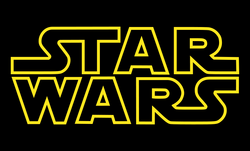
0 Response to "What Star Wars Movies Does Disney Own"
Postar um comentário